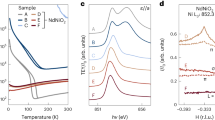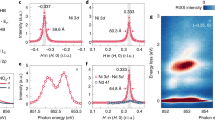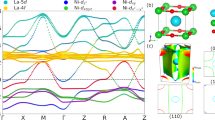Abstract
A defining signature of strongly correlated electronic systems is a rich phase diagram, which consists of multiple broken symmetries, such as magnetism, superconductivity and charge order1,2. In the recently discovered nickelate superconductors3,4,5,6,7,8,9,10, a large antiferromagnetic exchange energy has been reported, which implies the existence of strong electronic correlations11. However, signatures of a broken-symmetry state other than superconductivity have not yet been observed. Here we observe charge ordering in infinite-layer nickelates La1−xSrxNiO2 using resonant X-ray scattering. The parent compound orders along the Ni–O bond direction with an incommensurate wavevector, distinct from the stripe order observed in other nickelates12,13,14 that propagates along a direction 45° to the Ni–O bond. The resonance profile we measure indicates that ordering originates from the nickelate layers and induces a parasitic charge modulation of lanthanum electrons. Upon doping, the charge order diminishes and its wavevector shifts towards commensurate, hinting that strong electronic correlations are likely to be responsible for the ordered state. Our results suggest that the existence of charge order and its potential interplay with antiferromagnetic fluctuations and superconductivity are important themes in nickel-based superconductors.
This is a preview of subscription content, access via your institution
Access options
Access Nature and 54 other Nature Portfolio journals
Get Nature+, our best-value online-access subscription
$29.99 / 30 days
cancel any time
Subscribe to this journal
Receive 12 print issues and online access
$209.00 per year
only $17.42 per issue
Buy this article
- Purchase on Springer Link
- Instant access to full article PDF
Prices may be subject to local taxes which are calculated during checkout




Similar content being viewed by others
Data availability
All data presented in this work are available online at Harvard Dataverse35.
References
Dagotto, E. Complexity in strongly correlated electronic systems. Science 309, 257–262 (2005).
Fradkin, E., Kivelson, S. & Tranquada, J. M. Theory of intertwined orders in high temperature superconductors. Rev. Mod. Phys. 87, 457–482 (2015).
Li, D. et al. Superconductivity in an infinite-layer nickelate. Nature 572, 624–627 (2019).
Li, D. et al. Superconducting dome in Nd1−xSrxNiO2 infinite layer films. Phys. Rev. Lett. 125, 027001 (2020).
Zeng, S. et al. Phase diagram and superconducting dome of infinite-layer Nd1−xSrxNiO2 thin films. Phys. Rev. Lett. 125, 147003 (2020).
Osada, M. et al. A superconducting praseodymium nickelate with infinite layer structure. Nano Lett. 20, 5735–5740 (2020).
Osada, M., Wang, B. Y., Lee, K., Li, D. & Hwang, H. Y. Phase diagram of infinite layer praseodymium nickelate Pr1 − xSrxNiO2 thin films. Phys. Rev. Mater. 4, 121801 (2020).
Osada, M. et al. Nickelate superconductivity without rare-earth magnetism: (La,Sr)NiO2. Adv. Mater. 33, 2104083 (2021).
Gao, Q., Zhao, Y., Zhou, X. & Zhu, Z. Preparation of superconducting thin film of infinite-layer nickelate Nd0.8Sr0.2NiO2. Chin. Phys. Lett. 38, 077401 (2021).
Zeng, S. W. et al. Superconductivity in infinite-layer nickelate La1−xCaxNiO2 thin films. Sci. Adv. 8, eabl9927 (2022).
Lu, H. et al. Magnetic excitations in infinite-layer nickelates. Science 373, 213–216 (2021).
Tranquada, J. M. et al. Simultaneous ordering of holes and spins in La2NiO4.125. Phys. Rev. Lett. 73, 1003–1006 (1994).
Lee, S.-H. & Cheong, S.-W. Melting of quasi-two-dimensional charge stripes in La5/3Sr1/3NiO4. Phys. Rev. Lett. 79, 2514–2517 (1997).
Zhang, J. Stacked charge stripes in the quasi-2D trilayer nickelate La4Ni3O8. Proc. Natl Acad. Sci. USA 113, 8945–8950 (2021).
Anisimov, V. I., Bukhvalov, D. & Rice, T. M. Electronic structure of possible nickelate analogs to the cuprates. Phys. Rev. B 59, 7901–7906 (1999).
Hepting, M. et al. Electronic structure of the parent compound of superconducting infinite-layer nickelates. Nat. Mater. 19, 381–385 (2020).
Goodge, B. H. et al. Doping evolution of the Mott–Hubbard landscape in infinite-layer nickelates. Proc. Natl Acad. Sci. USA 118, e2007683118 (2021).
Zaanen, J., Sawatzky, G. A. & Allen, J. W. Band gaps and electronic structure of transition-metal compounds. Phys. Rev. Lett. 55, 418–421 (1985).
Lee, K.-W. & Pickett, W. E. Infinite-layer LaNiO2: Ni1+ is not Cu2+. Phys. Rev. B 70, 165109 (2004).
Sakakibara, H. et al. Model construction and a possibility of cupratelike pairing in a new d9 nickelate superconductor (Nd,Sr)NiO2. Phys. Rev. Lett. 125, 077003 (2020).
Botana, A. S. & Norman, M. R. Similarities and differences between LaNiO2 and CaCuO2 and implications for superconductivity. Phys. Rev. X 10, 011024 (2020).
Lee, P. A., Nagaosa, N. & Wen, X.-G. Doping a Mott insulator: physics of high-temperature superconductivity. Rev. Mod. Phys. 78, 17–85 (2006).
Phillips, P. Mottness. Ann. Phys. 321, 1634–1650 (2006).
Emery, V. J., Kivelson, S. A. & Tranquada, J. M. Stripe phases in high-temperature superconductors. Proc. Natl Acad. Sci. USA 96, 8814–8817 (1999).
Lin, J. Q. Strong superexchange in a d9−δ nickelate revealed by resonant inelastic X-ray scattering. Phys. Rev. Lett. 126, 087001 (2021).
Comin, R. & Damascelli, A. Resonant X-ray scattering studies of charge order in cuprates. Ann. Rev. Cond. Matter Phys. 7, 369–405 (2016).
Arpaia, R. & Ghiringhelli, G. Charge order at high temperature in cuprate superconductors. J. Phys. Soc. Jpn 90, 111005 (2021).
Peng, C., Jiang, H.-C., Moritz, B., Devereaux, T. P. & Jia, C. Superconductivity in a minimal two-band model for infinite-layer nickelates. Preprint at https://arxiv.org/abs/2110.07593 (2021).
Kitatani, M. et al. Nickelate superconductors—a renaissance of the one-band Hubbard model. npj Quantum Mater. 5, 59 (2020).
Rossi, M. et al. Orbital and spin characters of doped carriers in infinite-layer nickelates. Phys. Rev. B 104, L220505 (2021).
Hayward, M. A., Green, M. A., Rosseinsky, M. J. & Sloan, J. Sodium hydride as a powerful reducing agent for topotactic oxide deintercalation: synthesis and characterization of the nickel(I) oxide LaNiO2. J. Am. Chem. Soc. 121, 8843–8854 (1999).
Hayward, M. A. & Rosseinsky, M. J. Synthesis of the infinite layer Ni(I) phase NdNiO2 + x by low temperature reduction of NdNiO3 with sodium hydride. Solid State Sci. 5, 839–850 (2003).
Krieger, G. et al. Charge and spin order dichotomy in NdNiO2 driven by SrTiO3 capping layer. Preprint at https://arxiv.org/abs/2112.03341 (2021).
Tam, C. C. et al. Charge density waves in infinite-layer NdNiO2 nickelates. Preprint at https://arxiv.org/abs/2112.04440 (2021).
Rossi, M. et al. Replication data for: A broken translational symmetry state in an infinite-layer nickelate. Harvard Dataverse https://doi.org/10.7910/DVN/RWYHUJ (2022).
Acknowledgements
This work is supported by the US Department of Energy (DOE), Office of Science, Basic Energy Sciences, Materials Sciences and Engineering Division, under contract no. DE-AC02-76SF00515. We acknowledge the Gordon and Betty Moore Foundation’s Emergent Phenomena in Quantum Systems Initiative through grant no. GBMF9072 for synthesis equipment. We acknowledge the Diamond Light Source for time on beamline I21-RIXS under proposals MM25598 and MM27558. RSXS experiments were carried out at the SSRL (beamline 13-3), SLAC National Accelerator Laboratory, supported by the US DOE, Office of Science, Office of Basic Energy Sciences under contract no. DE-AC02-76SF00515. This research also used resources of the Advanced Light Source, a US DOE Office of Science User Facility under contract no. DE-AC02-05CH11231. D.J. gratefully acknowledges support from the Alexander-von-Humboldt Foundation via a Feodor–Lynen postdoctoral fellowship.
Author information
Authors and Affiliations
Contributions
M.R. and W.-S.L. conceived the research project and designed the experiments. M.R., H.L., D.J., Y.L., J.C., S.A., A.N., K.-J.Z. and W.-S.L. performed RIXS experiments at DLS and discussed the results. M.R., D.J., Y.L., H.L., C.-T.K., S.-J.L., J.-S.L. and W.-S.L. performed RSXS experiments at SSRL and discussed the results. M.R., H.L., Y.-D.C. and W.-S.L. performed RIXS experiments at ALS and discussed the results. M.O., B.Y.W., K.L. and H.Y.H. synthesized and characterized the samples. M.R. and W.-S.L. analysed the data. M.R., Z.-X.S., B.M., T.P.D., H.Y.H. and W.-S.L. interpreted the results. M.R. and W.-S.L. wrote the manuscript with input from all authors.
Corresponding author
Ethics declarations
Competing interests
The authors declare no competing interests.
Peer review
Peer review information
Nature Physics thanks Johan Chang and the other, anonymous, reviewer(s) for their contribution to the peer review of this work.
Additional information
Publisher’s note Springer Nature remains neutral with regard to jurisdictional claims in published maps and institutional affiliations.
Extended data
Extended Data Fig. 1 RIXS phonon softening in LaNiO2 at 20 K and fit of the spectra.
a, Representative RIXS spectrum of LaNiO2 (black circles) at q// = (0.4, 0) r.l.u. and corresponding fit (red solid line). The fit function includes a Gaussian for the elastic line (orange), anti-symmetrized Lorentzian for phonon (blue) and magnon (green) and a constant background (thin black line). The fit function is convolved with a Gaussian with FWHM = 36 meV. b, Phonon dispersion clearly showing the softening of the RIXS phonon. The phonon dispersion is also shown in Fig. 1a of the main text. c, Raw RIXS spectra of LaNiO2 (black circles) with fit superimposed (red lines). The data shown here were taken using σ incident photon polarization to optimize the RIXS phonon signal.
Extended Data Fig. 2 Magnetic excitations in LaNiO2 at 20 K and fit of the spectra.
a, RIXS intensity map of LaNiO2 measured with π incident photon polarization, which optimize the cross-section of the magnetic excitations. White circles correspond to the undamped mode energies of the magnetic excitation as determined from the damped harmonic oscillator function used for fitting the data. b, Intensity of the RIXS quasi-elastic line of LaNiO2 determined from a Gaussian fit. c, Representative RIXS spectrum of LaNiO2 (black circles) at q// = (0.4, 0) r.l.u. and corresponding fit (red solid line). The fit function includes a Gaussian for the elastic line (orange), anti-symmetrized Lorentzian for phonon (blue) and high-energy background (dashed line) and damped harmonic oscillator function for the magnon (green). The fit function is convolved with a Gaussian with FWHM = 40 meV. d, Raw RIXS spectra of LaNiO2 (black circles) measured with π polarization with fit superimposed (red lines).
Extended Data Fig. 3 Extraction of RSXS data from two-dimensional images.
a, Ni L3-edge RSXS scan of LaNiO2 at 33 K obtained by rotating the sample around the b axis (θ-scan), which is orthogonal to the scattering plane. Every column is obtained by integrating the rows of the two-dimensional CCD detector collected at a specific θ angle. The CO peak profile is obtained by integrating the columns near the centre of the detector (solid red window), while the background is estimated from the fluorescence signal collected at the top of the detector (dashed red window). The region of interest corresponds to k ~ ±0.015 r.l.u., while the top window corresponds to k ~ 0.02–0.03 r.l.u., which is well separated from the CO signal. b, The corresponding CO peak profile (thick solid line) and the fluorescence background (thin dashed line). In the main text, the theta angle is converted to in-plane momentum transfer.
Extended Data Fig. 4 CO peak profile of LaNiO2 measured at the La M4 and M5 absorption edges.
a, Waterfall plot showing RSXS scans of LaNiO2 as a function of temperature measured with incident photon energy tuned at the La M4 edge (~850.58 eV). b, CO peak profile obtained by fitting the RIXS quasielastic line measured at the La M5 edge (~834.1 eV). The CO signal is clearly visible at both absorption edges up to the highest measured temperature.
Rights and permissions
About this article
Cite this article
Rossi, M., Osada, M., Choi, J. et al. A broken translational symmetry state in an infinite-layer nickelate. Nat. Phys. 18, 869–873 (2022). https://doi.org/10.1038/s41567-022-01660-6
Received:
Accepted:
Published:
Issue Date:
DOI: https://doi.org/10.1038/s41567-022-01660-6
This article is cited by
-
Absence of 3a0 charge density wave order in the infinite-layer nickelate NdNiO2
Nature Materials (2024)
-
A deeper understanding
Nature Materials (2024)
-
Structural phase transition, s±-wave pairing, and magnetic stripe order in bilayered superconductor La3Ni2O7 under pressure
Nature Communications (2024)
-
A noticeable absence
Nature Materials (2024)
-
Direct observation of strong surface reconstruction in partially reduced nickelate films
Nature Communications (2024)



